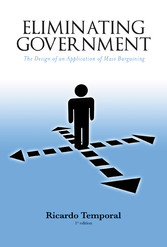Search and Find
Service
The application
The goal
The application is a mass bargaining system for trading public goods and services. The application takes the place of the intermediary between the individuals and the firms. The individuals send messages with their demands to the application, while the firms supply the projects. The people give their money to the application, the application gives their money to the private companies.
| Individuals | Mechanism | Firms |
The diagram shows a mechanism between the individuals and the firms.
What is a mechanism? The mechanism makes the decision of which projects should be run.
Definition: A mechanism is a mathematical function, where the domain of the function is the set of possible messages that the individuals can send and the image of the function is the set of decisions that affects the individuals.
Let m∈ℕ be the number of individuals in the society.
Let M be the set of messages an individual can send to the mechanism.
The domain set is the Cartesian product of all the sets of possible messages that each individual can send. In the mechanism designed here, there is nothing special about any individual. They all have the same set of possible messages. When these sets are the same, the product becomes the Cartesian power:
M×M×⋯×M⏟m=Mm
Let D be the set of decisions the mechanism can make affecting one individual.
Similarly, we apply the same rules for all, thus, the image set is Dm .
Let m1,m2,…,mm∈M be the messages sent by the individuals 1,2,…,m .
Let d1,d2,…,dm∈D be the decision that affects the individuals 1,2,…,m .
Let the function of the mechanism be declared by:
mechanism:Mm→Dm(m1,m2,⋯,mm)⟼(d1,d2,⋯,dm)
It is necessary for an application to support the mechanism; the application takes care of the communication and the execution of the decisions made by the mechanism.
The application collects the messages:
m1,m2,⋯,mm
The application runs the mechanism function:
(d1,d2,⋯,dm)=mechanism(m1,m2,⋯,mm)
The application performs the decisions:
d1,d2,⋯,dm
The application and the mechanism in this book are designed specifically to provide public goods and services.
Definition: Mechanism design is a field in economics that takes an engineering approach to design economic games with incentives toward desired objectives. The mechanism is a game. The goal is given, while the game is unknown. Therefore, it also is called reverse game theory.
The individuals who use the application also are called users. The individuals who play a game also are called players.
The individual
Definition: An individual can be a person or a firm. The individual can behave like a person or behave like a firm, simultaneously.
The individuals are shown like this in the application:
| Name | Public key | Balance |
| Ricardo | MIIBVAIB... | $120 |
| Jefferson | SUDCHAu4... | $70 |
| Thiago | YiCM6Ada.... | $100 |
| ACME | QG1vaLdK.... | $100 |
The individual generates a pair of keys of the RSA cryptosystem. One key is the public key that the individual sends to the application to be stored online. The other is the private key that the individual keeps offline. The length of the key can be 512 bits, 1024 bits, or longer. The keys are encoded in the base 64. For example, this is a key:
MIIBVAIBADANBgkqhkiG9w0BAQEFAASCAT4wggE6AgEAAkEAhe0h+Dp9MJim5f095dO824lyFwUodTZUKig9u7xO/IVHQuhE0m3CkZ9psUDCHAu4ppZgFNBnOZjU4QElXt1bbQIDAQABAkAgcFmkCHa+SJtUZcySWIEMI/Sqgt1T1r73ulhJmsj+/OVKqrHX3TosDNJhaO2lmhvhmc1UcFF7qFw3p5bm0vH5AiEA6FjDPExoJ8/b4NJp4PZO+VzVtmjZ+kKpzCYiCM6AdacCIQCTj2oUtN6kH0jNHb7uEp1XFIGfmrfyV2dodahV1yFwywIgWEJ3j20613y2+pUTUThfUYw5RnxX6R/vnjQSE6RV2dsCIB/1ZbJKYhYFuIzELn/9hBpCFLjul3xjNcBIC0dcKp/1AiEAqG1vaLdK/4tsecc+ccgu92aBakkRfy1De4UJsGWT+5g=
The private key is used to sign the data, while the public key is used to verify the signature.
The application must provide a checking account for the deposit of money that will be debited automatically to pay the projects. The individual makes deposits into this account.
The application should allow the user to withdraw the remaining balance upon request.
The asset
Definition: An asset in the application is a file that holds documents, images, videos, diagrams, and whatever is necessary to describe the asset.
Example: Suppose a firm offers many different projects for a streetlight. The streetlight has different qualities and different aesthetic values. In this case, there are different assets. The firm should create one asset for each proposal.
The assets are shown like this in the application:
| Name | Document | Video | Others | Hash |
| Streetlight on my street | 2fd4e1c6... |
| Waste collection | 7a2d28fc... |
| Donation of meals | ed849ee1... |
| Pavement of my avenue | bb76e739... |
The same asset can be referenced by many firms. The competitor can make a reference to the same asset, or the competitor can copy and paste the description to offer a slightly different asset.
The assets are immutable, i.e., once created, they cannot be changed. For example, the asset's documents, images, diagrams, and description all should be ready at the time of creation. Nevertheless, another asset can be created.
All the constant data is used to calculate the SHA-1 hash...
All prices incl. VAT













